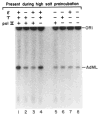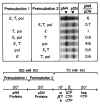Transcription initiated by RNA polymerase II and purified transcription factors from liver. Cooperative action of transcription factors tau and epsilon in initial complex formation
- PMID: 2332442
- PMCID: PMC3380428
Transcription initiated by RNA polymerase II and purified transcription factors from liver. Cooperative action of transcription factors tau and epsilon in initial complex formation
Abstract
Synthesis of accurately initiated transcripts has been reconstituted with RNA polymerase II and a set of five transcription factors purified from rat liver. In addition to three previously identified factors alpha, beta gamma, and delta (Conaway, R. C., and Conaway, J. W. (1989) Proc. Natl. Acad. Sci. U. S. A. 86, 7356-7360), transcription in the reconstituted liver system requires two novel factors designated tau and epsilon. These five transcription factors comprise two functional classes: (i) promoter recognition factors (tau and epsilon), which interact with template DNA to facilitate formation of a stable initial complex that is subsequently recognized and bound by RNA polymerase II, and (ii) RNA chain initiation factors (alpha, beta gamma, and delta), which do not participate in formation of the initial complex, but which are essential for transcription initiation.
Figures









Similar articles
-
Mechanism of assembly of the RNA polymerase II preinitiation complex. Transcription factors delta and epsilon promote stable binding of the transcription apparatus to the initiator element.J Biol Chem. 1992 May 15;267(14):10142-8. J Biol Chem. 1992. PMID: 1577784
-
Transcription initiated by RNA polymerase II and purified transcription factors from liver. Transcription factors alpha, beta gamma, and delta promote formation of intermediates in assembly of the functional preinitiation complex.J Biol Chem. 1990 May 5;265(13):7559-63. J Biol Chem. 1990. PMID: 1692022
-
A multisubunit transcription factor essential for accurate initiation by RNA polymerase II.J Biol Chem. 1989 Feb 5;264(4):2357-62. J Biol Chem. 1989. PMID: 2914911
-
Transcription initiated by RNA polymerase II and transcription factors from liver. Structure and action of transcription factors epsilon and tau.J Biol Chem. 1991 Apr 25;266(12):7804-11. J Biol Chem. 1991. PMID: 2019603
-
Purification of RNA polymerase II general transcription factors from rat liver.Methods Enzymol. 1996;273:194-207. doi: 10.1016/s0076-6879(96)73020-3. Methods Enzymol. 1996. PMID: 8791613 Free PMC article. Review.
Cited by
-
Transcription factor requirement for multiple rounds of initiation by human RNA polymerase II.Proc Natl Acad Sci U S A. 1991 Dec 1;88(23):10691-5. doi: 10.1073/pnas.88.23.10691. Proc Natl Acad Sci U S A. 1991. PMID: 1961736 Free PMC article.
-
The molecular basis of eukaryotic transcription.Proc Natl Acad Sci U S A. 2007 Aug 7;104(32):12955-61. doi: 10.1073/pnas.0704138104. Epub 2007 Aug 1. Proc Natl Acad Sci U S A. 2007. PMID: 17670940 Free PMC article. Review. No abstract available.
-
RNA polymerase II cofactor PC2 facilitates activation of transcription by GAL4-AH in vitro.Mol Cell Biol. 1994 Jun;14(6):3927-37. doi: 10.1128/mcb.14.6.3927-3937.1994. Mol Cell Biol. 1994. PMID: 8196633 Free PMC article.
-
An interplay between TATA box-binding protein and transcription factors IIE and IIA modulates DNA binding and transcription.Proc Natl Acad Sci U S A. 1998 Jun 9;95(12):6722-7. doi: 10.1073/pnas.95.12.6722. Proc Natl Acad Sci U S A. 1998. PMID: 9618479 Free PMC article.
-
Molecular characterization of Saccharomyces cerevisiae TFIID.Mol Cell Biol. 2002 Aug;22(16):6000-13. doi: 10.1128/MCB.22.16.6000-6013.2002. Mol Cell Biol. 2002. PMID: 12138208 Free PMC article.
References
-
- Matsui T, Segall J, Weil PA, Roeder RG. J Biol Chem. 1980;255:11992–11996. - PubMed
-
- Tsai SY, Tsai MJ, Kops LE, Minghetti PP, O’Malley BW. J Biol Chem. 1981;256:13055–13059. - PubMed
-
- Samuels M, Fire A, Sharp PA. J Biol Chem. 1982;257:14419–14427. - PubMed
-
- Davison BL, Egly JM, Mulvihill ER, Chambon P. Nature. 1983;301:680–686. - PubMed
-
- Dynan WS, Tjian R. Cell. 1983;32:669–680. - PubMed
Publication types
MeSH terms
Substances
Grants and funding
LinkOut - more resources
Full Text Sources

